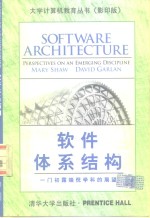

软件体系结构 一门初露端倪学科的展望PDF电子书下载
- 电子书积分:10 积分如何计算积分?
- 作 者:MaryShaw,DavidGarlan著
- 出 版 社:北京:清华大学出版社
- 出版年份:1998
- ISBN:730202832X
- 页数:244 页
CHAPTER 3 Case Studies 33
3.1 Key Word in Context 33
3.1.1 Solution 1: Main Program/Subroutine with Shared Data 34
3.1.2 Solution 2: Abstract Data Types 35
3.1.3 Solution 3: Implicit Invocation 36
3.1.4 Solution 4: Pipes and Filters 37
3.1.5 Comparisons 38
3.2 Instrumentation Software 39
3.2.1 An Object-Oriented Model 39
3.2.2 A Layered Model 40
3.2.3 A Pipe-and-Filter Model 41
3.2.4 A Modified Pipe-and Filter Model 41
3.2.5 Further Specialization 42
3.2.6 Summary 42
3.3.1 Design Considerations 43
By Marco Schumacher 43
3.3 Mobile Robotics 43
3.3.2 Solution 1: Control Loop 44
3.3.3 Solution 2: Layered Architecture 45
3.3.4 Solution 3: Implicit Invocation 47
3.3.5 Solution 4: Blackboard Architecture 49
3.3.6 Comparisons 51
3.4 Cruise Control 51
3.4.1 Object View of Cruise Control 53
3.4.2 Process-Control View of Cruise Control 53
3.4.3 Analysis and Discussion 58
3.4.4 Summary 60
3.5 Three Vignettes in Mixed Style 60
3.5.1 A Layered Design with Different Styles for the Layers 60
3.5.2 An Interpreter Using Different Idioms for the Components 63
3.5.3 A Blackboard Globally Recast as an Interpreter 66
4.1 Shared Information Systems 69
CHAPTER 4 Shared Information Systems 69
4.2 Database Integration 70
4.2.1 Batch Sequential 70
4.2.2 Simple Repository 71
4.2.3 Virtual Repository 75
4.2.4 Hierarchical Layers 79
4.2.5 Evolution of Shared Information Systems in Business Data Processing 80
4.3 Integration in Software Development Environments 82
4.3.1 Batch Sequential 83
4.3.2 Transition from Batch Sequential to Repository 83
4.3.3 Repository 85
4.3.4 Hierarchical Layers 86
4.3.5 Evolution of Shared Information Systems in Software Development Environments 88
4.4 Integration in the Design of Buildings 88
4.4.1 Repository 89
4.4.2 Intelligent Control 90
4.4.3 Evolution of Shared Information Systems in Building Design 91
4.5 Architectural Structures for Shared Information Systems 93
4.5.1 Variants on Dataflow Systems 93
4.5.2 Variants on Repositories 94
4.6 Some Conclusions 95
CHAPTER 5 Architectural Design Guidance 97
5.1 Guidance for User-Interface Architectures 97
by Thomas G. Lane 97
5.1.1 Design Spaces and Rules 97
5.1.2 A Design Space for User-Interface Architectures 100
5.1.3 Design Rules for User-Interface Architecture 110
5.1.4 Applying the Design Space: An Example 111
5.1.5 A Validation Experiment 113
5.1.6 How the Design Space Was Prepared 114
5.1.7 Summary 115
5.2.2 Background 116
5.2.1 Overview 116
5.2 The Quantified Design Space 116
by Toru Asada, Roy F. Swonger, Nadine Bounds, and Paul Duerig 116
5.2.3 Quantified Design Space 120
5.2.4 Conclusion 127
CHAPTER 6 Formal Models and Specifications 129
6.1 The Value of Architectural Formalism 129
6.2 Formalizing the Architecture of a Specific System 130
6.3 Formalizing an Architectural Style 133
6.3.1 Filters 134
6.3.2 Pipes 135
6.3.3 Pipe-and-Filter System 136
6.4 Formalizing an Architectural Design Space 139
6.5 Toward a Theory of Software Architecture 142
6.6 What Next? 142
6.7 Z Notation Used in This Chapter 143
7.1 Requirements for Architecture-Description Languages 147
CHAPTER 7 Linguistic Issues 147
7.1.1 The Linguistic Character of Architectural Description 148
7.1.2 Desiderata for Architecture-Description Languages 151
7.1.3 Problems with Existing Languages 155
7.2 First- Class Connectors 160
7.2.1 Current Practice 160
7.2.2 Problems with Current Practice 161
7.2.3 A Fresh View of Software System Composition 165
7.2.4 An Architectural Language with First- Class Connectors 166
7.2.5 The Promise of Explicit Architectural Notations 171
7.3 Adding Implicit Invocation to Traditional Programming Languages 172
7.3.1 Introduction 172
7.3.2 Adding Implicit Invocation to Ada 174
7.3.3 Evaluation 181
8.1 UniCon: A Universal Connector Language 183
CHAPTER 8 Tools for Architectural Design 183
8.1.1 Components and Connectors 185
8.1.2 Abstraction and Encapsulation 186
8.1.3 Types and Type Checking 187
8.1.4 Accommodating Analysis Tools 188
8.2 Exploiting Style in Architectural Design Environments 190
8.2.1 What Is Architectural Style? 190
8.2.2 Automated Support for Architectural Design 192
8.2.3 Observations about Environments for Architectural Design 202
8.3 Beyond Definition/Use: Architectural Interconnection 204
8.3.1 Implementation versus Interaction 205
8.3.2 Example 206
8.3.3 The WRIGHT Model of Architectural Description 208
8.3.4 Reasoning about Architectural Descriptions 210
8.3.5 A Brief Explanation of Our Use of CSP 211
9.1.1 Objectives 213
CHAPTER 9 Education of Software Architects 213
9.1 Philosophy and Course Overview 213
9.1.2 Approach 215
9.2 Course Description 215
9.3 Assignments 218
9.3.1 Purpose 218
9.3.2 Readings 219
9.3.3 Architectural Development Tasks 220
9.3.4 Formal Modeling 222
9.3.5 Analysis and Interpretation of a System 222
9.4 Evaluation 223
9.4.1 Lessons from the Initial Offering 223
9.4.2 Conclusions About Teaching Software Architecture 225
Bibliography 227
Index 239
- 《看漫画学钢琴 技巧 3》高宁译;(日)川崎美雪 2019
- 《联吡啶基钌光敏染料的结构与性能的理论研究》李明霞 2019
- 《异质性条件下技术创新最优市场结构研究 以中国高技术产业为例》千慧雄 2019
- 《“十三五”规划教材 中药鉴定学实验 供中药学 药学及相关专业使用 第2版》吴啟南 2018
- 《晚清民国船山学的接受与传播》吴戬著 2019
- 《清代宋词学研究》曹明升著 2019
- 《跟孩子一起看图学英文》张紫颖著 2019
- 《道路沥青流变学》王超著 2019
- 《柏里曼人体结构绘画教学描摹本 第2册 头手足结构》杨建飞主编 2019
- 《看漫画学钢琴 综合训练 2》高宁译;(日)川崎美雪 2019
- 《中风偏瘫 脑萎缩 痴呆 最新治疗原则与方法》孙作东著 2004
- 《水面舰艇编队作战运筹分析》谭安胜著 2009
- 《王蒙文集 新版 35 评点《红楼梦》 上》王蒙著 2020
- 《TED说话的力量 世界优秀演讲者的口才秘诀》(坦桑)阿卡什·P.卡里亚著 2019
- 《燕堂夜话》蒋忠和著 2019
- 《经久》静水边著 2019
- 《魔法销售台词》(美)埃尔默·惠勒著 2019
- 《微表情密码》(波)卡西亚·韦佐夫斯基,(波)帕特里克·韦佐夫斯基著 2019
- 《看书琐记与作文秘诀》鲁迅著 2019
- 《酒国》莫言著 2019
- 《大学计算机实验指导及习题解答》曹成志,宋长龙 2019
- 《指向核心素养 北京十一学校名师教学设计 英语 七年级 上 配人教版》周志英总主编 2019
- 《大学生心理健康与人生发展》王琳责任编辑;(中国)肖宇 2019
- 《大学英语四级考试全真试题 标准模拟 四级》汪开虎主编 2012
- 《大学英语教学的跨文化交际视角研究与创新发展》许丽云,刘枫,尚利明著 2020
- 《北京生态环境保护》《北京环境保护丛书》编委会编著 2018
- 《复旦大学新闻学院教授学术丛书 新闻实务随想录》刘海贵 2019
- 《大学英语综合教程 1》王佃春,骆敏主编 2015
- 《大学物理简明教程 下 第2版》施卫主编 2020
- 《指向核心素养 北京十一学校名师教学设计 英语 九年级 上 配人教版》周志英总主编 2019
